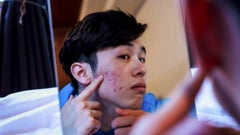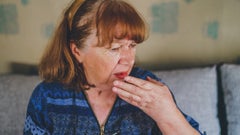
clindamycin
Clindamycin (Cleocin-T) is a topical antibiotic that is used to treat mild to moderate acne. When combined with other acne medications like benzoyl peroxide or retinoids like Retin-A, it can work quite well to treat acne. It's also available in many different formulations like lotion, gel, and solution.

What is Clindamycin (Cleocin-T)?
What is Clindamycin (Cleocin-T) used for?
Acne
How Clindamycin (Cleocin-T) works
Clindamycin (Cleocin-T) is an antibiotic. It treats acne by stopping acne-causing bacteria from growing and reproducing.
Drug Facts

Get your GoodRx coupon

What are the side effects of Clindamycin (Cleocin-T)?
Common Side Effects
- Skin irritation
- Dryness
- Redness
- Peeling
- Burning
- Oily skin
- Skin that's sensitive to the sun
Serious Side Effects
- Allergic reaction
- Severe diarrhea or stomach discomfort
Source: DailyMed
The following side effects have also been reported
Along with its needed effects, a medicine may cause some unwanted effects. Although not all of these side effects may occur, if they do occur they may need medical attention.
Check with your doctor immediately if any of the following side effects occur:
Check with your doctor as soon as possible if any of the following side effects occur:
Less common
Skin rash, itching, redness, swelling, or other sign of irritation not present before use of this medicine
Some side effects may occur that usually do not need medical attention. These side effects may go away during treatment as your body adjusts to the medicine. Also, your health care professional may be able to tell you about ways to prevent or reduce some of these side effects. Check with your health care professional if any of the following side effects continue or are bothersome or if you have any questions about them:
More common
Dryness, scaliness, or peeling of skin (for the topical solution)
Other side effects not listed may also occur in some patients. If you notice any other effects, check with your healthcare professional.
Call your doctor for medical advice about side effects. You may report side effects to the FDA at 1-800-FDA-1088.

Pros and cons of Clindamycin (Cleocin-T)

Pros
Available in generic form
Comes in different formulations (gel, solution, lotion, foam, swabs) to fit your lifestyle and perference
Works well for the kind of acne that causes large, red, and swollen pimples
Usually the first choice acne treatment for mild to moderate acne
There are prescription medications available that contain clindamycin combined with other popular acne medications like benzoyl peroxide or retinoid.

Cons
You will most likely have to use another acne medication along with clindamycin (Cleocin-T) since it doesn't work as well by itself.
It's only preferred for mild to moderate acne. If you have severe acne, your healthcare provider will most likely prescribe an oral medication.
If you only have comedonal acne (small skin-colored bumps on the skin) without any red, swollen pimples, your healthcare provider may give you a different medication.
Topical clindamycin (Cleocin-T) won't cure your acne, but it will help keep your acne under control.
You may need to use this medication for many weeks until you see your acne get better.

Pharmacist tips for Clindamycin (Cleocin-T)

Clean the affected area with mild soap and allow it to dry before applying clindamycin (Cleocin-T).
If you are using the lotion, shake it well before using it.
If you are using the swabs or pledgets, keep the jar closed when you're not using the medication to prevent them from drying out. Throw away each swab after using to prevent contamination and infection.
Wash your hands before and after using it.
Don't spray the foam product into your hands or face because the foam will melt. Spray the foam into the clear cap that came with the product. Your pharmacist can show you how to use and apply the foam product correctly.
Avoid using other harsh skin products that can further dry or irritate your skin.
Use sunscreen or wear a hat when you go out. Clindamycin (Cleocin-T) can make your skin more sensitive to sunlight. Be sure to avoid sunlamps and tanning booths too.
Include a moisturizer in your skin regimen to help get rid of any dryness. Speak to your healthcare provider or pharmacist if you need help choosing the best moisturizer for your skin.

Frequently asked questions about Clindamycin (Cleocin-T)

How to save using GoodRx




What are the risks and warnings for Clindamycin (Cleocin-T)?
Clindamycin (Cleocin-T) can cause some serious health issues. This risk may be even higher for certain groups. If this worries you, talk to your doctor or pharmacist about other options.

SKIN IRRITATION
Risk factors: Using other medicines or products that irritate the skin | Eczema | Extreme temperatures (hot or cold)
Clindamycin (Cleocin-T) may cause skin redness, burning, and peeling. Speak to your healthcare provider if the irritation is bothersome or doesn't go away.

SEVERE DIARRHEA AND STOMACH CRAMPS
Risk factors: Using clindamycin (Cleocin-T) for a long time
In some rare cases, clindamycin (Cleocin-T) can raise your chances of getting a serious and life-threatening bacterial infection. This is less likely to happen than if you were taking an oral antibiotic. If you have diarrhea with bloody stools and/or get severe stomach cramps while using clindamycin (Cleocin-T), talk to your healthcare provider right away. In some cases, this infection can develop even several weeks after you have stopped using the medication.

SUN SENSITIVITY
While on clindamycin (Cleocin-T), you'll be more sensitive to the sun and may sunburn more easily. Try to stay out of the sun, and use high SPF sunscreen and hats even if there's no sun out while using clindamycin (Cleocin-T).

Clindamycin (Cleocin-T) dosage forms
Typical dosing for Clindamycin (Cleocin-T)
Apply a thin layer one to two times a day on the skin where acne appears. Use enough to cover the entire affected area lightly.

Interactions between Clindamycin (Cleocin-T) and other drugs
Using this medicine with any of the following medicines is usually not recommended, but may be required in some cases. If both medicines are prescribed together, your doctor may change the dose or how often you use one or both of the medicines.
- Cholera Vaccine, Live
- Erythromycin
Using this medicine with any of the following medicines may cause an increased risk of certain side effects, but using both drugs may be the best treatment for you. If both medicines are prescribed together, your doctor may change the dose or how often you use one or both of the medicines.
- Atracurium
- Metocurine
- Tubocurarine

How much does Clindamycin (Cleocin-T) cost?

What are alternatives to Clindamycin (Cleocin-T)?
Treatment of inflammatory acne on the face in people ages 12 years and older

What is the latest news about Clindamycin (Cleocin-T)?

Clindamycin (Cleocin-T) images
Get savings updates for Clindamycin (Cleocin-T)
Receive price alerts, news, and other messages from GoodRx about Clindamycin (Cleocin-T) and other healthcare topics and relevant savings offers.By signing up, I agree to GoodRx's Terms and Privacy Policy, and to receive marketing messages from GoodRx.
Browse medications
View AllResearch prescriptions and over-the-counter medications from A to Z, compare drug prices, and start saving.













